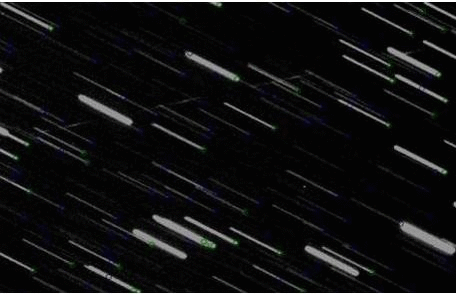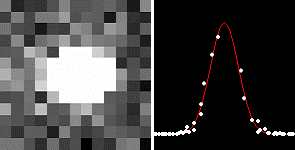
|
Results |

|
· NEO Astrometry
MPC Publications 2011 2010
· Asteroid rotation periods
· Papers |

|
Asteroid Astrometry
Astrometry is the measurement and recording of the position in the sky of an object expressed in right ascension (RA) and declination (DEC). Both are measures of angles in the equatorial co-ordinate system of the sky, similar to longitude and latitude used to measure position on the surface of Earth. The fixed attitude of the Earth’s polar axis and the fixed position of stars in the sky is the basis of this co-ordinate system. For objects moving in this co-ordinate system such as planets, asteroids (minor planets) and comets, position measurement must also include time. For scientific purposes position must be accurate to better then one second of arc (1/3600 of a degree) and better then one second of UT (universal time). For asteroids and comets observations of position and time measurements are sent to the Minor Planet Center (MPC) following their strict format described in Guide to Minor Planet Astrometry. Observations of asteroids sent to the MPC are used to update the orbital parameters of known asteroids. The database of orbits of known (numbered/named) asteroids now stands at more then 600,000. Knowing the accurate, up to date orbital parameters is an asteroid enables its location in the sky to be calculated at any future (or past) time. The prediction of future positions of planets and asteroids is known as generating the ephemeris for the object. This is available from NASA’s Jet Propulsion Laboratory (JPL) for every object in the solar system at the click of a button.. Continuous observation and update of asteroid orbits is necessary because the orbits of small objects in the solar system is subject to unpredictable perturbation by the major planets such as Jupiter and Saturn.
Methods
Modern astrometry is based on imaging the night sky using a digital camera. Digital cameras that are designed for astronomy feature the ability to image extremely faint objects. This is achieved by exposure control (up to hours of exposure) and cooling the imaging chip to reduce signal noise. Otherwise, astronomical digital cameras (CCD cameras) designed for amateur astronomy are not too different to your standard DSLR cameras in terms of resolution and imaging chip size. Astronomical CCD cameras are usually monochrome to improve light sensitivity. Single shot colour cameras are used by amateurs to produce “pretty pictures”. For serious colour astronomical photography colour filters are used with monochrome cameras.
For astrometry involving the measurement of the position of point sources in the image, digital cameras are ideal with their rectangular pixel arrays already providing a virtual co-ordinate system where the relative position of a point source such as a star can be read off as the x and y co-ordinates of the illuminated pixel. In reality the situation is not that simple. Due to a number of factors including the fundamental limitation of the telescopes lens (diameter) the image of a point source is not a single illuminated pixel on the imaging chip but a circular patch whose theoretical size depends on the diameter or the primary lens or the mirror.
Image of point source (star) Point Spread Function (Credit Herbert Raab)
The actual number of pixels illuminated depends further on the focal length of the optics and the actual size of the pixels on the chip. For optimum accuracy the image of the remote point source should cover an area bounded by a circle of radius of about 3 or 4 pixels. The distribution of light intensity across the pixels illuminated by the point source follows a characteristic curve called the point spread function (PSF). The exact position of the projected point source on the CCD chip represented by the peak of the point spread function. It is the task of the astrometry software used to find the parameters, including the position of the peak, of the PSF best fitting the illuminated pixels of the image of the point source. This method allows the estimation of the position of the point source to an accuracy on the CCD chip to much better than the size of a single pixel, to typically better than a tenth of a pixel. The pixel co-ordinates of the object being measured must then be related to its position in the sky. This is done by using a set of known “reference stars” identified in the image. A typical image may have from a few dozen to thousands of reference stars, whose position is known to high accuracy, in the image. With the help of the rough sky position of the centre of the image specified by the user, the software uses one of the public star catalogues (e.g UCAC4) online to look up and identify the visible reference stars in the image and calculate the “plate constants” for the image. Basically these are equations converting pixel co-ordinates to sky positions in Right Ascension and Declination. Pointing and clicking any part of the image on screen gives its exact position to 0.1 arc second accuracy. Astrometrica is the most popular of the professional grade astrometry software available. In addition to measuring position and brightness it can also generate a record with time stamp in the required format ready to be sent to the Minor Planet Center (MPC) in case of asteroid observations. Reference paper on astrometry by Herbert Raab can be found here.
|

|
To contact us: | E-mail: andras@arcadiaobservatory.org
|